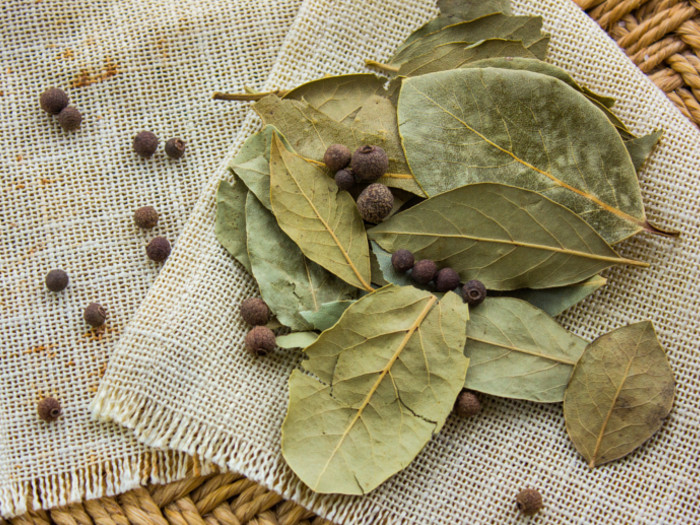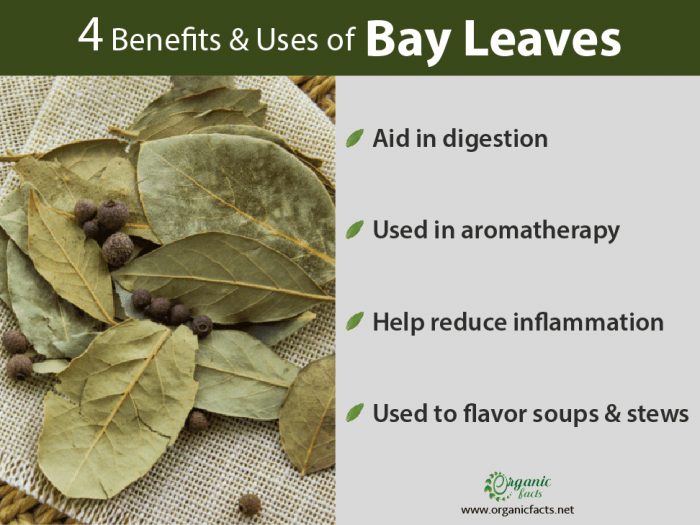Bay leaves, a fragrant culinary herb, are renowned not just for their distinctive flavor but also for their array of health benefits. These leaves, scientifically known as Laurus nobilis, originate from the laurel tree native to the Mediterranean region and have been a part of both culinary and medicinal practices since ancient Roman times. Beyond their use in enhancing the taste of various dishes, bay leaves are gaining recognition for their potential in managing diabetes, reducing inflammation, and aiding digestion. In this blog, we’ll explore the diverse benefits of bay leaves, their nutritional profile, and how they can be incorporated into daily health and wellness routines.
What are Bay Leaves?
There are many types of plants containing leaves referred to as “bay leaves”, but the true bay leaf is scientifically known as Laurus nobilis. This is the nutrient-rich variety that is discussed in the article. Many other leaves have a similar appearance and aroma like true bay leaves, but not the same nutrient content. This plant is a small tree native to the Mediterranean region. Laurel trees were present everywhere in the region, but changing climates have diminished their presence. However, these leaves have been a part of the culinary and medicinal world for thousands of years, dating to at least the ancient Roman times.
How to Use Bay Leaves?
The uses of bay leaves include grinding the leaves into a spice to flavor soups and stews, but they are most commonly added in their whole form as a flavoring for certain Italian dishes. They are removed from the dish prior to consumption or used as a garnish. Whole leaves are not commonly consumed. There is no extensive range of culinary applications for bay leaves, although extracts of these leaves have numerous medical uses. These leaves are also a popular element in aromatherapy and herbal treatments for various skin and respiratory conditions.

Dried bay leaves Photo Credit: Shutterstock
| Serving Size : | |
|---|---|
| Nutrient | Value |
| Water [g] | 5.44 |
| Energy | 313 |
| Energy [kJ] | 1312 |
| Protein [g] | 7.61 |
| Total lipid (fat) [g] | 8.36 |
| Ash [g] | 3.62 |
| Carbohydrate, by difference [g] | 74.97 |
| Fiber, total dietary [g] | 26.3 |
| Calcium, Ca [mg] | 834 |
| Iron, Fe [mg] | 43 |
| Magnesium, Mg [mg] | 120 |
| Phosphorus, P [mg] | 113 |
| Potassium, K [mg] | 529 |
| Sodium, Na [mg] | 23 |
| Zinc, Zn [mg] | 3.7 |
| Copper, Cu [mg] | 0.42 |
| Manganese, Mn [mg] | 8.17 |
| Selenium, Se [µg] | 2.8 |
| Vitamin C, total ascorbic acid [mg] | 46.5 |
| Thiamin [mg] | 0.01 |
| Riboflavin [mg] | 0.42 |
| Niacin [mg] | 2.01 |
| Vitamin B-6 [mg] | 1.74 |
| Folate, total [µg] | 180 |
| Folate, food [µg] | 180 |
| Folate, DFE [µg] | 180 |
| Vitamin A, RAE [µg] | 309 |
| Vitamin A, IU [IU] | 6185 |
| Fatty acids, total saturated [g] | 2.28 |
| 8:0 [g] | 0.01 |
| 10:0 [g] | 0.01 |
| 12:0 [g] | 0.53 |
| 14:0 [g] | 0.21 |
| 16:0 [g] | 1.27 |
| 18:0 [g] | 0.16 |
| Fatty acids, total monounsaturated [g] | 1.64 |
| 16:1 [g] | 0.14 |
| 18:1 [g] | 1.5 |
| Fatty acids, total polyunsaturated [g] | 2.29 |
| 18:2 [g] | 1.24 |
| 18:3 [g] | 1.05 |
| Sources include : USDA [1] | |
Health Benefits of Bay Leaves
With the wide range of benefits that these powerful leaves may offer, it is necessary to include them in your diet. Let us explore them in detail.
May Improve Digestion
Bay leaves, a staple in culinary traditions, are recognized for their ability to alleviate various digestive issues. A 2019 report in the Medicinal Plants of South Asia Journal highlights that bay leaves are not just flavor enhancers but also aid in relieving abdominal pain, gastrointestinal infections, flatulence, bloating, constipation, and diarrhea. However, most of these claims have not been verified on humans. [2]
Furthermore, based on another animal study bay leaves contribute to gastrointestinal health by protecting against gastric damage and encouraging urination, which helps in detoxifying the body and maintaining kidney health. [3]
While these benefits are promising, further research is necessary to fully establish the effectiveness of bay leaves on digestion.
Can Help Relieve Respiratory Conditions
Bay leaves have strong antibacterial properties as per research published in the Biological and Pharmaceutical Bulletin. [4]
When the essential oil of bay leaves is extracted, it can be mixed into a salve and applied to the chest to help alleviate various respiratory conditions. This can also be achieved with a poultice made of the leaves. Spread it on the chest and allow it to remain overnight. Inhaling the vapor has a similar effect to aromatherapy and can loosen up the phlegm and eliminate dangerous bacteria that may be trapped in your respiratory tracts, thanks to its natural antibacterial quality.
Note: However, it is highly recommended to consult a health specialist before trying this remedy at home.
Might Aid As An Anti-inflammatory Agent
Bay leaves are renowned for their anti-inflammatory properties. A study in the Phytotherapy Research journal confirms this, highlighting bay leaf’s effectiveness in reducing bodily inflammation as observed in mice and rats. [5]
A study investigated the anti-inflammatory potential of various herbal extracts, including bay leaf, using a lipopolysaccharide-activated murine macrophage model. The findings showed that pretreatment with these herbal extracts, especially bay leaf, significantly reduced pro-inflammatory enzymes and their by-products, indicating strong anti-inflammatory effects. [6]
Moreover, bay leaves contain parthenolide, a unique phytonutrient known for its rapid relief of inflammation and irritation when applied topically to areas like sore joints or those affected by arthritis. This anti-inflammatory benefit can also be gained through regular consumption of bay leaf as a spice.

The uses of bay leaves include grinding the leaves into a spice to flavor soups and stews.
Can Help Reduce Anxiety & Stress
Bay leaves contain linalool, a compound usually associated with thyme and basil, known for its stress-reducing properties. When used in aromatherapy, linalool can significantly lower stress hormone levels, contributing to a calmer and more relaxed state, especially in moments of high anxiety. This ability to reduce stress hormones is crucial for maintaining long-term health. However this claims were only tested on rats. [7]
Supporting this, a 2010 study focusing on the effects of inhaled linalool vapor demonstrated its potential to promote relaxation and alleviate anxiety in mice, suggesting similar benefits could be experienced by humans. [8]
More human research is required to further validate this claim.
May Aid in Diabetes Management
Bay leaves show potential in managing diabetes, particularly in improving insulin receptor function and regulating blood sugar levels. Their regular consumption could be significant for individuals at risk of diabetes or those already diagnosed, potentially reducing the occurrence of diabetic episodes. However, further research with larger sample sizes is needed to strengthen these findings. [9]
A study involving 65 people with type 2 diabetes observed remarkable results. Participants were divided into two groups, with one group receiving capsules containing 2g of bay leaves daily for 30 days. This group experienced a significant 30% reduction in plasma glucose levels, a 22% decrease in total cholesterol, a 24% reduction in Low-Density Lipoprotein (LDL), an 18% increase in High-Density Lipoprotein (HDL), and a 25% decrease in triglycerides. No notable changes were observed in the placebo group. This study suggests bay leaves could be beneficial for managing type 2 diabetes and associated cardiovascular risk factors. [10]
Word of Caution: As mentioned earlier, “bay leaf” is a commonly used term that applies to many different plants around the world; however, to achieve all of the health benefits listed above, it is essential that you find a true bay leaf, derived from the laurel tree. Other varieties can actually be toxic when consumed, so be certain that you’re getting the real thing. In terms of allergies, bay leaves aren’t widely known as an allergenic substance, but contact dermatitis and eczema breakouts have been sporadically reported. If you’re allergic to other members of the Lauraceae family, you will likely be allergic to bay leaves as well. [11]
Final Thoughts
In conclusion, bay leaves, a humble yet powerful herb, offer a multitude of health benefits that extend well beyond their culinary use. From aiding digestion and respiratory health to managing diabetes, these leaves are a natural powerhouse of healing properties. The anti-inflammatory and stress-reducing qualities of bay leaves make them a valuable addition to any diet. While more research is needed in certain areas, the existing studies provide compelling evidence of their potential health benefits. Remember, it’s crucial to use true bay leaves, Laurus nobilis, to reap these benefits fully. As with any herbal remedy, it’s important to use bay leaves judiciously and be aware of any allergies. Embracing bay leaves in your daily routine can be a simple yet effective step towards a healthier lifestyle.
